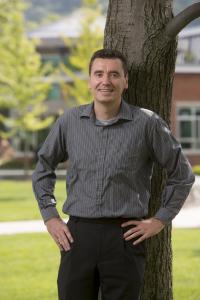Home > Press > Binghamton physicist contributes to creation of first computer-designed superconductor
 |
| Kolmogorov and his international colleagues report this week on the successful synthesis of the first superconductor designed entirely on the computer.
Credit: Jonathan Cohen, Binghamton University Photographer |
Abstract:
A Binghamton University scientist and his international colleagues report this week on the successful synthesis of the first superconductor designed entirely on the computer. Their findings were published in Physical Review Letters, the leading journal in the field.
Binghamton physicist contributes to creation of first computer-designed superconductor
Binghamton, NY | Posted on October 8th, 2013Aleksey Kolmogorov, assistant professor of physics at Binghamton, proposed the new superconductor in Physical Review Letters in 2010 and then teamed up with European experimentalists to test the prediction.
The synthesized material — a novel iron tetraboride compound — is made of two common elements, has a brand-new crystal structure and exhibits an unexpected type of superconductivity for a material that contains iron, just as predicted in the original computational study.
"Paradigm-shifting superconducting materials have so far been discovered experimentally, and oftentimes accidentally," Kolmogorov says.
Until now, theory has been used primarily to investigate superconducting mechanisms and, in rare cases, suggest ways that existing materials might be modified to become superconductors. But many proposed superconducting materials are not stable enough to form and those that do form are poor superconductors.
Superconductors, which conduct electric current without any resistance when cooled below a certain temperature, have many interesting applications. For instance, power lines made out of superconducting materials can significantly reduce the energy lost in transmission.
The phenomenon was discovered more than 100 years ago, with breakthroughs in the 1960s bringing superconductivity into practical application. The critical temperature, or Tc, for superconductors discovered to date is between 0 and 136 Kelvin (-460 and -214 degrees Fahrenheit). Scientists are still searching for materials that are superconductors at higher temperatures and can be mass-produced.
Several years ago, Kolmogorov, then at Oxford University, began studying boron-based materials, which have complex structures and a wide range of applications. He developed an automated computational tool to identify previously unknown stable crystal structures. His "evolutionary" algorithm emulates nature, meaning it favors more stable materials among thousands of possibilities.
The search revealed two promising compounds in a common iron-boron system, which came as a surprise. Moreover, a graduate student's calculations indicated that one of them should be a superconductor at an unusually high temperature of 15-20 Kelvin for the considered (so-called "conventional") type of superconductivity.
Months of double-checking confirmed the preliminary results on the stability and superconductivity of the compound. Still, the 2010 theoretical discovery was met with skepticism.
Natalia Dubrovinskaia and Leonid Dubrovinsky, professors at the University of Bayreuth in Germany, undertook a series of experiments and produced a very small quantity of iron tetraboride in the predicted crystal structure, leading to the latest article. Detailed measurements demonstrated the material's predicted superconducting property and, unexpectedly, its exceptional hardness.
"The discovery of this superhard superconductor demonstrates that new compounds can be brought into existence by revisiting seemingly well-studied systems," Kolmogorov says. Now that this material has been synthesized, it may be possible to modify it and raise the temperature at which it becomes a superconductor.
####
For more information, please click here
Contacts:
Ryan Yarosh
607-777-2174
Copyright © Binghamton University
If you have a comment, please Contact us.Issuers of news releases, not 7th Wave, Inc. or Nanotechnology Now, are solely responsible for the accuracy of the content.
| Related News Press |
Superconductivity
News and information
![]() Researchers develop molecular qubits that communicate at telecom frequencies October 3rd, 2025
Researchers develop molecular qubits that communicate at telecom frequencies October 3rd, 2025
![]() Next-generation quantum communication October 3rd, 2025
Next-generation quantum communication October 3rd, 2025
![]() "Nanoreactor" cage uses visible light for catalytic and ultra-selective cross-cycloadditions October 3rd, 2025
"Nanoreactor" cage uses visible light for catalytic and ultra-selective cross-cycloadditions October 3rd, 2025
Discoveries
![]() Researchers develop molecular qubits that communicate at telecom frequencies October 3rd, 2025
Researchers develop molecular qubits that communicate at telecom frequencies October 3rd, 2025
![]() Next-generation quantum communication October 3rd, 2025
Next-generation quantum communication October 3rd, 2025
![]() "Nanoreactor" cage uses visible light for catalytic and ultra-selective cross-cycloadditions October 3rd, 2025
"Nanoreactor" cage uses visible light for catalytic and ultra-selective cross-cycloadditions October 3rd, 2025
Announcements
![]() Rice membrane extracts lithium from brines with greater speed, less waste October 3rd, 2025
Rice membrane extracts lithium from brines with greater speed, less waste October 3rd, 2025
![]() Researchers develop molecular qubits that communicate at telecom frequencies October 3rd, 2025
Researchers develop molecular qubits that communicate at telecom frequencies October 3rd, 2025
![]() Next-generation quantum communication October 3rd, 2025
Next-generation quantum communication October 3rd, 2025
![]() "Nanoreactor" cage uses visible light for catalytic and ultra-selective cross-cycloadditions October 3rd, 2025
"Nanoreactor" cage uses visible light for catalytic and ultra-selective cross-cycloadditions October 3rd, 2025
Interviews/Book Reviews/Essays/Reports/Podcasts/Journals/White papers/Posters
![]() Spinel-type sulfide semiconductors to operate the next-generation LEDs and solar cells For solar-cell absorbers and green-LED source October 3rd, 2025
Spinel-type sulfide semiconductors to operate the next-generation LEDs and solar cells For solar-cell absorbers and green-LED source October 3rd, 2025
![]() Rice membrane extracts lithium from brines with greater speed, less waste October 3rd, 2025
Rice membrane extracts lithium from brines with greater speed, less waste October 3rd, 2025
|
|
||
|
|
||
| The latest news from around the world, FREE | ||
|
|
||
|
|
||
| Premium Products | ||
|
|
||
|
Only the news you want to read!
Learn More |
||
|
|
||
|
Full-service, expert consulting
Learn More |
||
|
|
||








